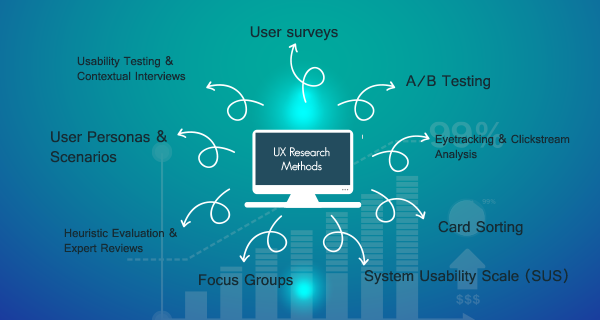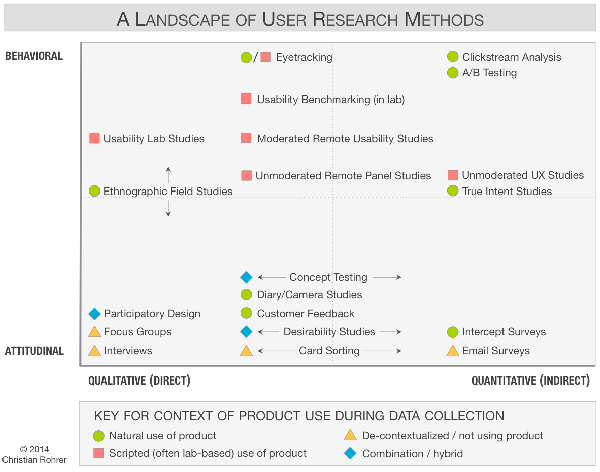Understanding the UX Research Methods
Although the user experience field is relatively new and is still developing, UX-ers already have plenty of methods and techniques in their toolbox. So let’s now go through the extensive list of UX research methods, have a brief overview of each method and understand the type of questions they answer.
Depending on the type of user issue, you may need to use more than one UX method to answer the research questions, so it’s good to have an understanding of what each of the methods is and how it is used.
Now, in order not to get lost in a long list of different UX methods, let’s try to structure them into categories. This way you will also be able to easily navigate them in future.
So user experience methods, just like any other research methods are usually categorized into quantitative and qualitative methods based on the type of question they answer.
Quantitative UX research methods use mathematical analysis to derive insights from analyzed data and answer questions like “how much, how many, how often?” etc. Whereas qualitative research methods directly observe user behavior and try to explain user motivations and attitude, answering the “why” type of questions.
There’s also a different approach to UX research methods developed by Christian Rohrer, which categorizes the most widely used 20 UX methods along 2 dimensions: quantitative-qualitative and attitudinal-behavioral. Here’s what it looks like:
As you can see, in the lower half of the chart we have UX methods that research what users say, their attitude. These methods include focus groups, interviews, surveys, card sorting, etc. These methods help understand or measure users’ self-reported beliefs, opinions, likes and dislikes.
You know, quite often what people say differs from what they actually do. So on the other end of this dimension we have UX research methods that focus on users’ behavior rather than opinion. For example, eyetracking and clickstream analysis can show just how exactly users navigate the website: through the menu or search, regardless of what they say they do.
In this same chart you can also see how the methods appear along quantitative – qualitative dimensions.
So going back to our extensive list of UX research methods, here’s how we can group them.
Quantitative methods include:
- User surveys
- A/B testing
- Eyetracking and clickstream analysis
- Card sorting
- System Usability Scale (SUS)
Qualitative methods include:
- Focus groups
- Heuristic Evaluation and expert reviews
- User personas and scenarios
- Usability testing and contextual interviews

Now let’s have a quick overview of the listed methods one by one.
User Surveys
A user survey is basically a questionnaire that users complete through filling out a form. Surveys are great for a number of reasons;
- They are cheap
- With surveys you can get answers to a wide range of questions, such as who your users are; What your users want; What they think of your brand or product; What information your users are looking for, etc
- Surveys are easy to conduct and analyze, especially with the free online services nowadays.
The bad thing about surveys is that they usually require a relatively large sample size to get reliable results. And if you don’t have a big internal contact list of users, then this method becomes quite costly.
A/B Testing
The same as split testing, A/B tests determine which of the two alternatives, A or B, are better received by the target audience. This is an effective method to see which option works better based on actual user behavior. A/B testing is widely used to evaluate different design options, call-to-actions and basically anything.
So if the research goal is measurable through user’s actions, then A/B testing can be very insightful. For example, if you need to understand which of the email subscription forms is more effective in terms of user signups, then you can easily split-test the forms and see which one wins.
Eyetracking and Clickstream Analysis
These are two different studies, although we put them together here. Eye tracking studies provide such information that users cannot report and the researcher cannot observe. Eye tracking is conducted using special equipment, which can be either static, mounted on the computer screen or mobile device, or wearable, like glasses. Eye tracking equipment can be quite expensive, so this method is not something every researcher can have in their toolbox.
However, eye tracking data combined with clicks analysis can provide insights into such questions, as how efficiently a design guides users through a task; how participants read — in detail or by scanning; which design elements are distracting in a negative way, etc.
Card Sorting
This method is generally used to organize the content in your digital product so that users can easily navigate it and find what they need. With card sorting you can test and evaluate the usability of information architecture and adjust accordingly.
System Usability Scale
Although this method was developed long ago, back in 1986 by John Brooke, it is still used as a “quick and dirty” tool to evaluate usability. The method is basically a survey consisting of 10 questions with five response options for each one.
All these methods use quantitative data analysis.
Now let’s pass on to the qualitative methods.

Focus Groups
This is a traditional market research technique widely used by marketing professionals. It can also be useful for a UX research. A focus group involves 5-10 users who participate in a moderated discussion and you as a UX researcher try to derive insights about users’ beliefs, expectations and preferences. The drawback of this method is that you don’t get to see users act upon and verify the collected information.
Heuristic Evaluation and Expert Reviews
A heuristic evaluation is the process of reviewing the interface of a product to see how well it complies with the generally acknowledged 10 usability heuristics. Traditionally a heuristic evaluation involves multiple usability professionals, but through the years this method has evolved into something we now call “expert reviews”. During an expert review a UX-er examines a user interface to identify usability, design and other user experience problems, as well as gives recommendations on how to fix them.
User Personas and Scenarios
Personas are great way to always keep the target user of your product in the center of everything you do. A user persona is a very realistic representative of the target audience, while a scenario is basically the context, the situation in which the persona uses your product.
Usability Testing and Contextual Interviews
The most widely used UX research method is certainly usability testing. A usability test is the process of evaluating the product with actual target users. And a usability test can have many different formats, that’s why I’ve put contextual interviews next to it. A contextual interview is basically the usability test conducted in the user’s own, natural environment, as opposed to being in a lab.
Conclusion
So, this was a very brief overview of the most widely used UX research methods. It’s not a complete list though, and you may even develop your own research methods. But overall, these are the techniques that you are going to use very often in your research projects.
